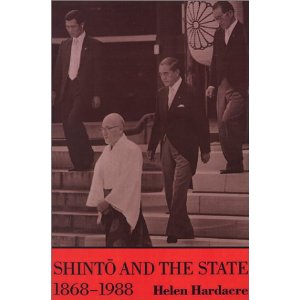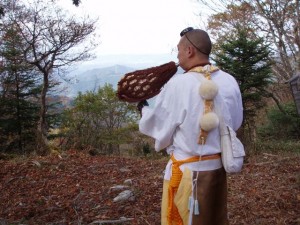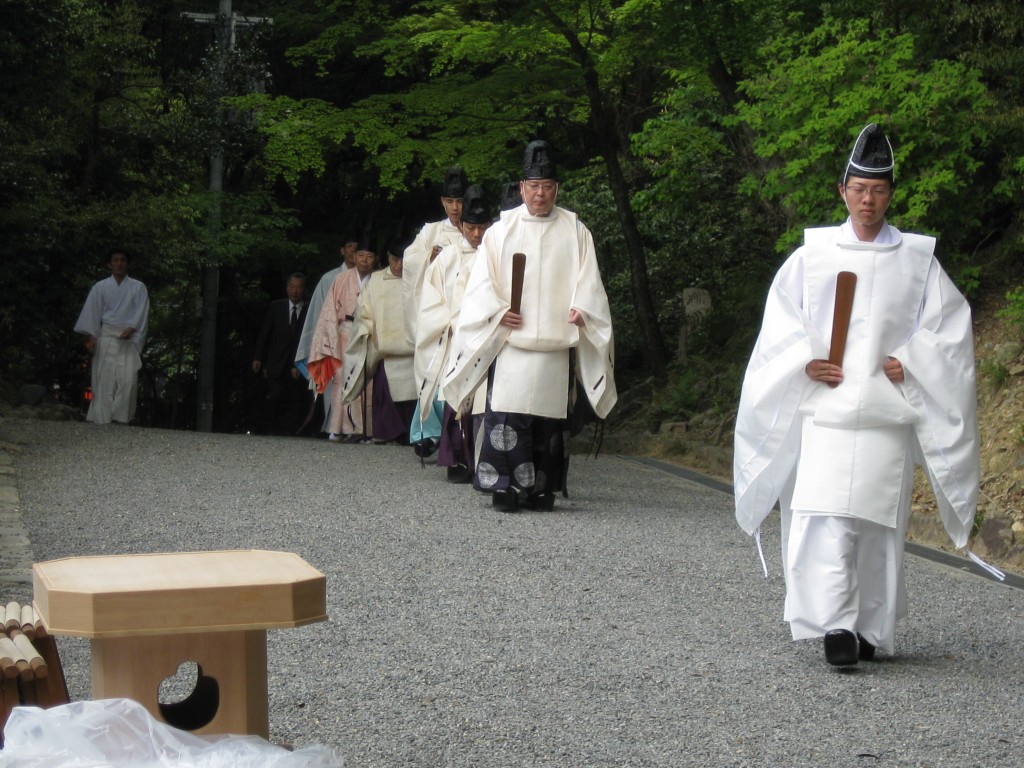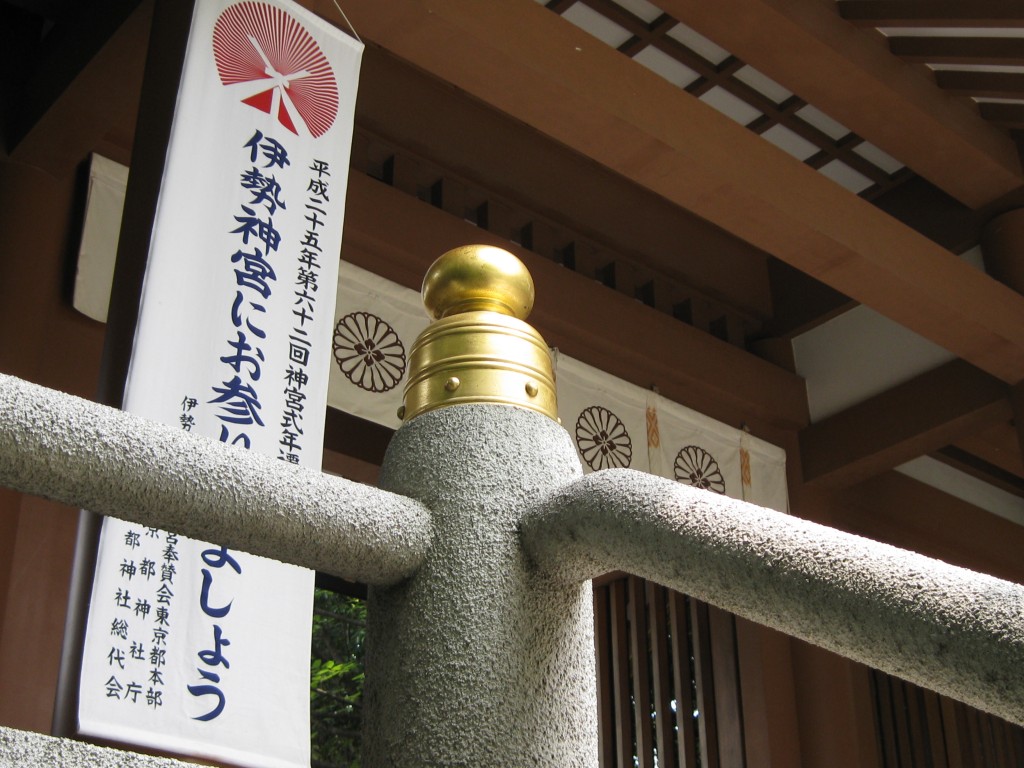Shinto and the State 1868-1988
Helen Hardacre Princeton University Press, 1989
**************************************************************
‘Nowhere else in modern history do we find so pronounced an example of state sponsorship of a religion – in some respects the state can be said to have created Shinto as its official “tradition”.’
Helen Hardacre’s book covers a century of modern Shinto, arguing that the religion as we know it is an invention of Meiji ideologues to support the authority of the new state. This led to the excesses of State Shinto, where loyalty to the emperor was posited as the supreme virtue. Moreover, the book suggests that, despite the decoupling of state and religion following defeat in WW2, the framework constructed by Meiji reformists remains in place. In short, Shinto as we now know it is an ‘invented tradition’.
(The term ‘invented tradition’ was coined by Eric Hobsbawn in 1983 to denote the way that in the nineteenth century, faced with the unsettling effects of industrialisation, states drew on the past to foster a sense of continuation and belonging.)
 Published 25 years ago, Hardacre’s trenchant analysis is bolstered by factual detail, which does not always make easy reading, but the book remains in print and is regarded as a classic. It’s the definitive work in English. The author is a distinguished academic, currently at Harvard University where she is Reischauer Professor of Japanese Religions and Society. (At the time of writing she was professor at Griffith University, Australia.)
Published 25 years ago, Hardacre’s trenchant analysis is bolstered by factual detail, which does not always make easy reading, but the book remains in print and is regarded as a classic. It’s the definitive work in English. The author is a distinguished academic, currently at Harvard University where she is Reischauer Professor of Japanese Religions and Society. (At the time of writing she was professor at Griffith University, Australia.)
In order to set the Meiji reforms in context, Hardacre describes Shinto in the Edo era as ‘ a mere appendage’ to Buddhism. There were, it is true, localised cults with independent lineages, but there was no central authority. Moreover, there was no unified training of priests. Indeed, there were precious few ‘Shinto priests’ (perhaps just 5%), since the vast majority of kami worship was conducted by Buddhist monks, shugendo practitioners, shamans, or village elders.
Since the Tokugawa regime privileged Buddhism as a tool of state, the result was that most shrines were under Buddhist control. Larger shrines were part of syncretic complexes known as miyadera run by Buddhist priests. Even the few independent institutions such as Ise and Izumo had close Buddhist connections, and Hardacre states that in Ise there were a scarcely credible 300 temples.
Among the populace at large there was little if any consciousness of something called ‘Shinto’. (Even today many of my students don’t know the word.) Kami worship was carried out, but not in any kind of structured or organised fashion. ‘In an institutional sense,’ summarises Hardacre, ‘Shinto has no legitimate claim to antiquity.’
The first signs of change to the status quo came with Nativism, or Kokugaku as it is known. Hardacre does not spend much time on this, which is regrettable since it’s crucial to the formation of modern Shinto, particularly the nationalist aspects. Inspired by Confucian notions of studying the past, thinkers such as Kamo no Mabuchi and others looked back to an idealised ‘pure’ Japanese past before foreign ideas polluted the homeland.

Shugendo was banned by the Meiji Reformists in 1872 and its adherents forced to choose between Shinto and Buddhism. The ban was only lifted in 1947.
Motoori Norinaga was particularly influential in asserting the supremacy of Japan, driven by a loathing of the Chinese and their rationality. By contrast, the Japanese were held up as intuitive, harmonious, and naturally virtuous. Moreover, they had an unbroken imperial line which was descended from the gods, proving their divinity. The populace would by rights revere the emperor, as in the mythical past, but his authority had been usurped by military shoguns. In this way an ideology was conveniently at hand for the anti-shogunate movement of the 1860s.
When the Restorationists came to power, they drew on the ideas of Kokugaku to foster an emperor-centred state (in effect run by themselves). In this they were inspired by the role of Christianity in the West. In promoting a state religion, they spread the idea that Shinto had been suppressed under Buddhism. Consequently the split of Buddhism and Shinto in 1868 was far from amicable, and in some cases the two elements had to be forcibly torn apart.
The ‘construction’ of the new religion is covered by Hardacre in some detail. Shrines were ranked in a hierarchy, with the imperial shrine of Ise at the apex. Rather than an agricultural deity, Amaterasu was championed as founder of the imperial lineage, and Ise was thus privileged as the ancestral shrine of the emperor. The bias towards imperial ancestors was reflected in Izumo’s Okuninushi being excluded from the national pantheon. At the same emphasis was given to Yasukuni as a place to commemorate those who had died in the service of the emperor – a new idea.
The intention of the Meiji reformers was to bolster the authority of Ise, and thus the emperor, and thereby those who ran the state in his name. 70 Daijingu, or Kotai Jingu, were established as branches of Ise to promote the imperial shrine nationwide. Moreover, the notion was spread that every house should have an Ise talisman.
Between 1903 and 1920 there was a massive state-sponsored reorganisation of shrines to firm up the imperial connection. A ‘one village one shrine’ policy led to the closure of thousands of shrines with local deities – some 83,000 shrines disappeared nationwide. In their place officially sanctioned imperial kami were promoted, and ancestral tombs of the emperor’s lineage identified by experts (often mistakenly).

Modern priest families largely owe themselves to the reforms of Meiji times
Whereas kami worship was conducted for the most part without a Shinto priest in Edo times, rituals were now carried out by a unified priesthood trained by a centralised organisation. The Imperial Rescript on Education strengthened the notion of imperial divinity, and the idea was spread that Shinto rites were not religious but a part of national life. Hardacre notes that priests were eager to embrace these reforms, since it brought them state patronage, though the general populace were less enthusiastic.
The result of the Meiji-era reforms was that Shinto became a servant of state, and as the country moved towards militarisation, the new religion fell in behind it. ‘A strong association between Shinto and war was the inevitable result,’ writes Hardacre, ‘and the priesthood voiced no reservations about the use of shrines to glorify death in battle.’
The excesses of the war period are well-known, but it is in the closing chapter of her book that Hardacre performs her most valuable function. There is a tendency to think of State Shinto as having been decisively dismantled by American reforms in the Occupation Period. Hardacre suggests otherwise, noting that the Meiji-era institutions remain essentially in place. Moreover, ‘the priesthood overwhelmingly favors a return to the prewar situation,’ she notes. What she doesn’t mention is the influence of inheritance on this, as the vast majority of priests come from Shinto families who benefitted from the Meiji reforms and therefore owe their vocation and livelihood to them.
The National Association of Shrines, Jinja Honcho, was established in 1946 and is officially independent, though it continues to devote the bulk of its efforts to bolstering the authority of Ise. Teeuwen and Breen have noted the deleterious effect of this on the finances of local shrines. The efforts of the present ruling party (LDP) to legitimise Yasukuni serve similar ends in being ‘a clear reassertion of prewar values’. The invented traditions of the Meiji Restoration thus continue to set the agenda.
This book is an essential read for anyone seriously concerned with the present state of modern Shinto. It not only provides a context for the understanding of contemporary issues, but shows how and why they are rooted in the past. As George Orwell noted, those who control the present determine the past, and the notion that Shinto is the continuation of an age old tradition is one of the ways in which history is manipulated. Though this book is now nearly 25 years old, the intervening years have done little to date the arguments, and the weight of evidence is overwhelming. Hardacre surely proves her case.

A banner promoting worship at Ise in one of the country's 80,000 shrines - the National Association of Shrines has made this official policy, in the manner of the Meiji reforms

Leave a Reply